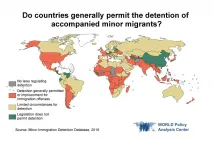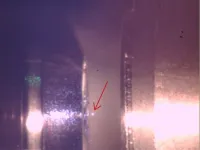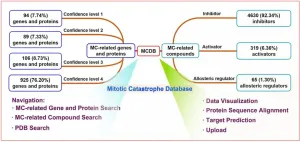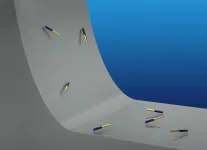There are two strategies with which humans and animals navigate and orient themselves. One involves locating places, distances and directions in "allocentric" or other-centered frames of reference rooted in the external world. The other strategy involves "egocentric" frames of reference that are centered on the self.
Whenever you use a mobile phone app to find driving directions, it will likely employ both these modes of navigation. When you first type in an address, it will normally show you the address on a map from an allocentric perspective, with 'north' at the top and 'south' at the bottom. When you then go to route view, it will switch to an egocentric perspective where 'ahead' is at the top and 'behind' is at the bottom.
Scientists first discovered brain cells linked with allocentric frames of reference in rats in 1971 -- "place cells" that may, for example, indicate that one is located in the northeast corner of an area. Other allocentric spatial cell types include head-direction cells that may activate whenever one is navigating south, or border cells that may respond when a boundary is located to the west.
In the past decade, researchers began investigating how rat brains mapped egocentric frames of reference. Two years ago, scientists at Dartmouth College in Hanover, New Hampshire, identified a brain region in rats called the postrhinal cortex in which egocentrically tuned cells are abundant. However, it remained poorly understood what brain cells formed the basis of egocentric spatial maps in humans.
"In humans it is only rarely possible to directly record the activity of single neurons from the brain, due to ethical reasons," said Lukas Kunz, a postdoctoral research scientist at Columbia University's Department of Biomedical Engineering and first author of the new study. "There are techniques like fMRI or EEG, which allow us to indirectly measure neural activity from healthy human brains, but this neural activity reflects the sum activity of millions of neurons, which does not allow for direct conclusions about the working principles of single neurons."
In the new study, neuroscientists from the United States and Germany investigated 15 epilepsy patients at the University of Freiburg's Medical Center in Germany. These volunteers were implanted with electrodes to help doctors monitor their disorder.
The researchers asked the volunteers to perform computer tasks that explored their ability to navigate through virtual environments and to remember where many different objects were located there. At the same time, the scientists recorded the activity of more than 1,400 single neurons in multiple brain regions across all the participants.
The scientists identified more than 160 neurons that behaved like egocentric spatial cell types, activating when specific parts of the virtual environment were ahead, behind, to the left, or to the right of the patients, or when points in space were close to or far away from the patients.
"We are now the first to report egocentric spatial cell types in humans," Kunz said. The scientists published their study, "A neural code for egocentric spatial maps in the human medial temporal lobe," in the journal Neuron on July 14, 2021.
These "egocentric bearing cells" likely encode spatial information on a mental map centered on each person. "This is presumably important for everyday life, when humans try to orient themselves in their environments and when they navigate along routes," said Joshua Jacobs, associate professor of biomedical engineering at Columbia Engineering and senior author of the study.
These egocentric bearing cells were particularly ample in the parahippocampal cortex, a region located deep within the brain that prior work suggested is the human equivalent of the rodent postrhinal cortex. Egocentric bearing cells comprised about 25% of all neurons in the parahippocampal cortex. "Previous studies had shown that patients with damage to this brain region are disoriented, presumably because their egocentric bearing cells were affected," Kunz said.
The researchers also found these egocentric bearing cells showed increases in activity when the patients used their memory to successfully recall the locations of objects they had found in the virtual environments. "This suggests these cells are not only relevant for navigation, but also play a role in correctly remembering past experiences," Kunz said.
"Memories consist of multiple different elements, such as a specific event, the place where the event happened, and the time when the event happened," Kunz said. "We believe that there are different neural systems for the different components of these memories. Egocentric bearing cells are presumably particularly involved in processing the spatial information of the memories."
These findings may illuminate what might go wrong in people with memory deficits, including patients with neurodegenerative diseases such as Alzheimer's. "Their egocentric bearing cells may not function correctly, or may have been destroyed for some reason, such as a stroke, a brain tumor, or dementia," Jacobs said.
These new findings do not answer how one might deal with such memory impairments. "There is still a lot of research to do before memory impairments can be treated successfully," Kunz cautioned.
In the future, the researchers want to see why exactly any given egocentric bearing cell is tuned to whatever point in space it is focused on. Currently, Kunz and his colleagues assume that multiple different spatial cues, such as objects, spatial boundaries and landmarks, combine to influence the position of these reference points. The scientists can examine the influence these cues have on the location of these reference points by removing these cues from environments during experiments.
"Another important question is how egocentric bearing cells interact with allocentric spatial cell types, Kunz said. "We currently hypothesize that egocentric bearing cells provide essential input to allocentric spatial cell types. By understanding this, future studies could explain how the tuning of allocentric spatial cell types is influenced by the functioning of egocentric bearing cells."
INFORMATION:
About the Study
The study is titled "A neural code for egocentric spatial maps in the human medial temporal lobe."
The study appeared in the journal Neuron on July 14, 2021.
Authors are: Lukas Kunz, Armin Brandt, Peter C. Reinacher, Bernhard P. Staresina, Eric T. Reifenstein, Christoph T. Weidemann, Nora A. Herweg, Ansh Patel, Melina Tsitsiklis, Richard Kempter, Michael J. Kahana, Andreas Schulze-Bonhage, Joshua Jacobs.
Department of Biomedical Engineering, Columbia Engineering
This work received funding from the German Research Foundation, the German Federal Ministry of Education and Research, NSF grant BCS-1724243, NIH/NINDS grant U01 NS1113198-01, NIH grant MH55687, NIH grant MH061975, NIH grant MH104606, a travel grant from the Boehringer Ingelheim Fonds, research grants from the Fraunhofer Society and the Else Kröner-Fresenius Foundation, and a Wellcome Trust/Royal Society Sir Henry Dale Fellowship.
Columbia Engineering
Columbia Engineering, based in New York City, is one of the top engineering schools in the U.S. and one of the oldest in the nation. Also known as The Fu Foundation School of Engineering and Applied Science, the School expands knowledge and advances technology through the pioneering research of its more than 220 faculty, while educating undergraduate and graduate students in a collaborative environment to become leaders informed by a firm foundation in engineering. The School's faculty are at the center of the University's cross-disciplinary research, contributing to the Data Science Institute, Earth Institute, Zuckerman Mind Brain Behavior Institute, Precision Medicine Initiative, and the Columbia Nano Initiative. Guided by its strategic vision, "Columbia Engineering for Humanity," the School aims to translate ideas into innovations that foster a sustainable, healthy, secure, connected, and creative humanity.



